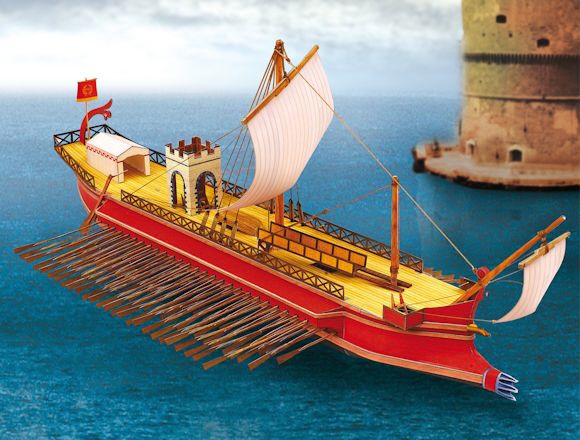Roman Qinquereme

Scale: 1:100
Length: 52 cm
Width: 22 cm
Height: 21 cm
Degree of difficulty: 3 (difficult)
Number of sheets: 6
Roman Quinquereme
This kind of Roman war ship can be translated literally as „five-oarer“. The oarsmen were assigned to three levels. It was not possible to have more levels, as otherwise the ships wouldn’t have been manoeuvrable. With the quinquereme, there was one man to each oar at the lower level, and two oarsmen to each oar in the upper levels. The five oarsmen at each of the three levels of oars formed one section. There were ships with up to 30 sections, so that 150 oarsmen sat at each side. A ship could therefore be moved by up to 300 oarsmen.
The quinquereme was a development of the Carthaginian trireme (“three-oarer”). In the 3rd century B.C. the Romans had adjusted them to meet their needs. At that time, 100 ships of this kind belonged to the Roman war fleet, in spite of the fact that the Romans had not had much experience with sea battles yet. For that reason, in the Punic Wars (264-241 BC and 218-201 BC) they used a different fighting method: instead of using the battering ram at the bow of the ship in order to capsize the enemy, the Romans first damaged the ships with projectiles and then stormed them using a boarding ramp (corvus). In addition to the corvus, the quinquereme other facilities such as a battle tower. However, that also created a disadvantage: in order to accommodate the new facilities, the ships had to be made larger and wider. Therefore, they were no longer so fast and manoeuvrable. After the Punic Wars the corvus once more disappeared from the quinquereme. Tradition has it that this type of ship was still used up to the time of Emperor Nero.
A Roman quinquereme is not to be confused with a galley ship. While the crew of a galley consisted of slaves, the oarsmen on a quinquereme were free citizens from the poorest social class, who were paid well for their service on the ship. It was only in cases of emergency that slaves were used and for that purpose they were set free. A possible reason for this was that free citizens were considered to be more reliable.
